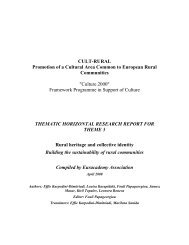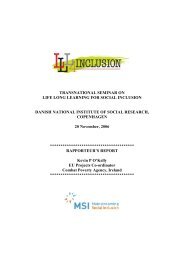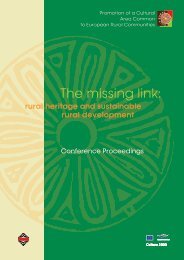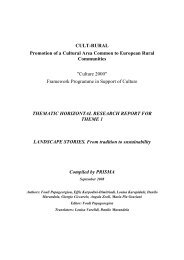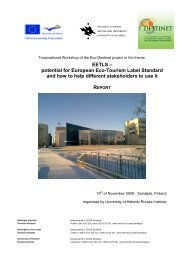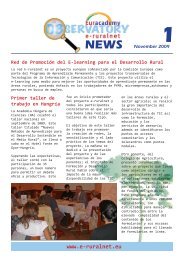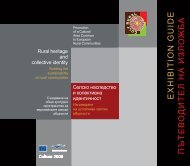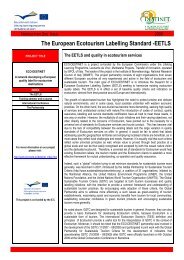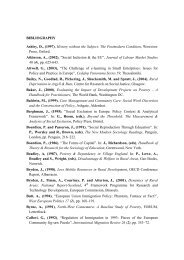Research report by the Jagiellonian University, Poland - cult rural
Research report by the Jagiellonian University, Poland - cult rural
Research report by the Jagiellonian University, Poland - cult rural
- No tags were found...
You also want an ePaper? Increase the reach of your titles
YUMPU automatically turns print PDFs into web optimized ePapers that Google loves.
10freedoms than peasants in o<strong>the</strong>r regions of <strong>the</strong> country. Besides, in Podhale <strong>the</strong> serfdomeconomy did not develop. This fact was considered <strong>by</strong> many researches to be decisive forshaping <strong>the</strong> highlanders’ character, <strong>the</strong>ir independence and pride. These features are alsopermanently inscribed in <strong>the</strong> stereotype image of highlanders, which has been successfullypresent for 200 years in <strong>the</strong> awareness of <strong>the</strong> Polish society. The permanent settlements inPodhale date back to <strong>the</strong> middle of <strong>the</strong> 13 th century. The harsh mountain climate, infertile soil,forest area did not encourage people to settle <strong>the</strong>re. Also <strong>the</strong> rulers were not interested in thisarea, thinking that <strong>the</strong> natural border zone in <strong>the</strong> form of <strong>the</strong> Tatras and <strong>the</strong> primeval forest aresufficient protection. Only when <strong>the</strong> danger of losing this land to <strong>the</strong> Hungarian Kingdomappeared to be real <strong>the</strong> Polish rulers initiated colonial action. In <strong>the</strong> first stage of settling <strong>the</strong>German settlers played an important role. They were mainly brought from Saxony and <strong>the</strong>neighbouring Spisz. In <strong>the</strong> 16 th century a huge wave of Italian settlers reached <strong>the</strong> area ofPodhale. They were Slavicated shepherds of Romanian origin, coming from Wallahians’ land– <strong>the</strong> land which spread over <strong>the</strong> Danube. As suggested <strong>by</strong> <strong>the</strong> researchers of this matter in13 th century Wallahians left <strong>the</strong>ir homeland and toge<strong>the</strong>r with herds of sheep <strong>the</strong>y started <strong>the</strong>irtravel to <strong>the</strong> north-east, later migrating along <strong>the</strong> whole arch of <strong>the</strong> Carpathians. The shepherdeconomy which was spread <strong>by</strong> <strong>the</strong> Wallahians and <strong>the</strong> tradition related to it, stamped a greatinfluence on <strong>the</strong> life of people of Podhale, deciding to a great extent on <strong>the</strong> shape of <strong>cult</strong>uralpeculiarity of Podhale, so different, due to <strong>the</strong> shepherd origin, from <strong>the</strong> lowland areas of<strong>Poland</strong>. As late as until <strong>the</strong> middle of <strong>the</strong> 20 th century in Podhale <strong>the</strong> basic trade was seasonalhigh mountain shepherdship with a developed system of shelter grazing and rich ritual sphere.In <strong>the</strong> beginning of <strong>the</strong> 20 th century <strong>the</strong> shepherdship in <strong>the</strong> official interpretation of <strong>the</strong>Podhale regionalism was recognized to be a foundation of <strong>the</strong> folk tradition of Podhale,becoming <strong>the</strong> subject of special protection. At present, although <strong>the</strong> shepherd economy isbeing replaced <strong>by</strong> expanding tourism industry, it is in <strong>the</strong> centre of priorities of <strong>the</strong> strategyfor <strong>the</strong> development of <strong>the</strong> region. The representatives of local authorities as well as regionalactivists undertake actions intended to preserve this traditional branch of economy. One ofmeasurable effects in this field may be <strong>the</strong> fact that this year <strong>the</strong> sheep cheese from Podhale,<strong>the</strong> so-called “oscypek” was granted <strong>the</strong> status of a regional product in <strong>the</strong> European Union.Today’s commonly known and often visited Podhale was “discovered” for <strong>the</strong> Polish<strong>cult</strong>ure of <strong>the</strong> 19 th c. after <strong>Poland</strong> lost its independence in <strong>the</strong> result of <strong>the</strong> third partitionperformed in 1795 <strong>by</strong> three neighbouring superpowers, <strong>the</strong> Tatras and <strong>the</strong> <strong>cult</strong>ure of <strong>the</strong> localpeople acted as reviving source. Polish artists intellectuals, enchanted <strong>by</strong> <strong>the</strong> landscape and<strong>cult</strong>ural values of Podhale, and also encouraged <strong>by</strong> <strong>the</strong> greater than in <strong>the</strong> remaining




